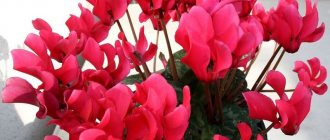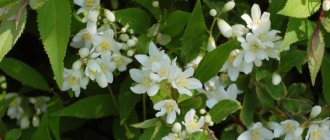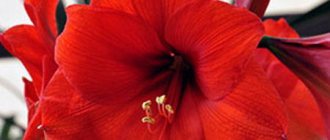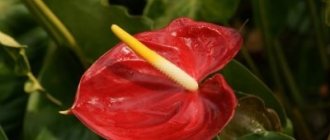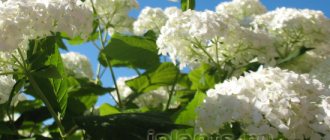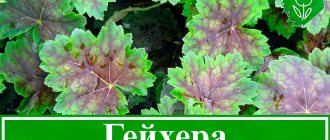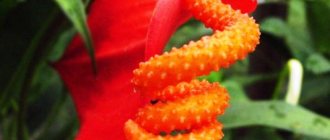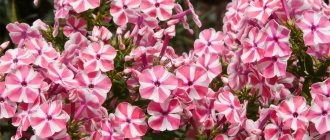Botanical description and names
Anthurium andreanum is an evergreen perennial of the Anthurium genus and belongs to the large aroid family. The Anthurium genus has more than 800 species. The herbaceous plant grows as a terrestrial and epiphytic flower, and can grow into voluminous branching vines.
Reference! Literally translated, the name of the plant means “flower” and “tail,” which characterizes the structure of the flower itself. People call this flower “male happiness”, “flamingo flower”.
Anthurium: types and varieties
The genus Anthurium includes about 600-1000 different species, which primarily grow in the tropical forests of South and Central America. However, only two species are grown as houseplants:
Anthurium Andreanum (lat. Anthurium andreanum)
Anthurium Andre produces particularly large inflorescences that can be used as cut flowers. As a potted plant, it takes up a lot of space; with good care, it can reach a height of up to one meter. The glossy, richly colored bracts are often up to 15 centimeters long. They then grow into a real flower: a thick yellowish head on which the individual flowers can be recognized as small cones.
Scherzer's Anthurium (lat. Anthurium scherzerianum)
Unlike Andre's hybrids, Anthurium Scherzer plants reach a height of only about 30 centimeters, and the single flowers are much smaller. The bract is also small and less shiny. In addition, the head is often orange-red in color, twisted in a spiral, and looks like a pig's tail.
Both species were named after their discoverers, Carl Scherzer and Edouard François André, two European botanists who first described these plants in the second half of the 19th century.
Representatives of the tropics usually do not know the seasons, so new leaves are formed all year round. We usually breed not the original species, but their hybrids.
Crystal anthurium (lat. Anthurium Crystallinum) has especially decorative leaves. On the dark green background of the leaf there is a white pattern with veins. But this anthurium does not form an attractive decorative flower. It is relatively small and light green in color.
Popular varieties:
- Anthurium Picco Bello: bract and head pale pink, growth height 50-75 centimeters.
- Anthurium Otazu: burgundy-brown bracts, yellow heads, growth height 50-75 centimeters.
- Anthurium Prince of Orange: bright orange bracts, yellow heads, growth height up to 75 centimeters.
- Anthurium Turenza: red bracts, yellow heads, growth height up to 75 centimeters.
- Anthurium White Champion: white bracts, light yellow heads, growth height up to 75 centimeters.
- Anthurium Princess Alexia Jade: white bracts, pink heads, growth height up to 75 centimeters.
- Anthurium Violet Heart: purple bracts, white and yellow heads, growth height up to 85 centimeters.
History of origin, description of appearance and geography of habitat
The first classification of the Anthurium genus was made in the 19th century.
Austrian botanist Heinrich Schott. Later in the 20th century. German botanist Gustav Engler grouped known species into 18 sections. In modern floriculture, Schaeffer's classification is used, which identifies 19 main groups of the Anthurium genus. Among them is a large species of Anthurium Andre. The plant's homeland is considered to be the tropical regions of South America, southwestern Colombia, and Ecuador. The habitat of natural species is rocky mountain slopes, tropical forest trees, rocky areas.
Anthurium Andre (anthurium andrianum in Latin) is a rather large flower. In nature it can grow up to 1 - 1.5 m. At home, the height of the plant reaches 80 - 90 cm. The stems are knotty and form thin aerial roots. The leaves are large, bright green, glossy. The length of the leaf plate is 20 -30 cm, width - 10 - 12 cm. The petioles are long, dense, up to 20 - 30 cm. The inflorescence is a yellow spadix, up to 10 cm in length. After fertilization, round fruits of orange color are formed on the cob.
The bract is a glossy covering, may be leathery, heart-shaped. The surface of the bedspread is streaked with relief veins. The color of the bedspread is bright red. Hybrid subvarieties can have pink, white, yellow bract colors (we talked about varieties with white flower color here, and read about pink varieties here). Flowering is long-lasting, up to 6 – 8 months. The plant blooms at the end of winter and lasts until autumn.
What diseases plague anthurium?
If anthurium does not bloom at home, but only grows green mass, the most likely reason is the presence of diseases and various types of pests. Excessive fertilization and improper care can also lead to this condition.
But it should be noted that when growing a crop such as anthurium at home: diseases and their treatment are those moments that gardeners are least concerned about. After all, chokeberry plants are toxic to most pests. Therefore, defeats occur infrequently. Sometimes you can see avocado scale insects or aphids. In the first case, it is enough to treat the flower with a regular soap solution. In the second case, nicotine sulfate is used. The leaf plates are sprayed with it, and after a day they are washed with clean water.
Usually, if the leaves of anthurium dry out at home or there is no flowering, the reason lies in a violation of the rules of care. For example, with poor irrigation, spots and dots appear on the leaves. The plates turn yellow and dry out. By adjusting watering, the condition will soon improve. Unsuitable soil also often affects the leaves. Especially if there is excess calcium. The leaves turn brown and curl.
Due to high humidity, anthurium is sometimes affected by fungal infections. Gray rot manifests itself as a white coating on stems and greenery. Cured with Topsin and removal of the affected parts of the culture. Rarely, but still the crop suffers from chlorosis. In this case, the veins on the leaf remain green, and the rest turns yellow. To correct the situation, you should feed the anthurium with mixtures that contain elements such as iron and magnesium.
Popular subspecies of Anthurium andreanum and their photos
Turenza
Hybrid compact variety, grows up to 50 – 60 cm in height. The leaves are shiny and dense. It is distinguished by pronounced veins on the dark green surface of the leaf blade. The bedspread is bright red. Grows well at home.
Red
The leaves are large, shiny, bright green. The leaves are heart shaped. The inflorescence is a large spike, located on the very cover of the flower. The bedspread is large, glossy, rich red. The height of an adult bush is up to 70 cm.
We talked about red anthuriums in this material.
Champion
The bush is compact, plant height up to 60 cm. The foliage is dark green and large. The leaf plate is glossy. The ears are straight and may have a pinkish or yellow tint. Bracts - spathes, depending on the andraeanum subcultivar, can be pink (Pink) or white (White).
Mix
To create colorful group mixes, several varietal varieties of andre anthurium, differing in the shade and size of leaves and bracts, can be planted in one container (or one bed). For example, delicate bedspreads of Andre Silens anthurium will go perfectly with pink Andre Favorite anthurium. The bright, rich red varieties Otazu and Belize will favorably emphasize the spectacular dark shades of the Fiorino and Black Queen varieties (read about black anthuriums here, and the Black Prince (Black Queen) variety is discussed in this material).
We talked about the types and varieties of anthuriums here.
Description and distinctive features of the anthurium plant
The birthplace of the flower is considered to be Central and South America. There the plant is called flamingo flower and fire tongue. Anthurium is also called Male Happiness, because it is customary to present it as a gift to men. The inflorescences are heart-shaped. Brightly colored and always eye-catching. Thanks to this spectacular appearance, the plant is widely used as a houseplant.
The flower can reach a meter in height. The leaves are quite large, up to 40 centimeters long. Dense, leathery, dark green in color. Sometimes a waxy coating is present. The shape is heart-shaped, elongated, broadly lanceolate. The edges are cut or whole. The leaves look very attractive. But the main decoration is considered to be exotic inflorescences. They are small, collected in a dense cob of a spiral or cylindrical shape. Around the base of the cob there are brightly colored, large leaves of a red hue. They are called a veil. This unusual combination gives the bush originality.
The color range is quite wide. There are specimens in blue, burgundy, and red. Pink and white anthurium looks beautiful. There are also dark, almost black options. In our latitudes, bright red flowers are considered the most common. As for maintenance, caring for white anthurium is similar to caring for plants of any other color.
Anthurium has a specific, slightly tart aroma. Looks great in pots and cut flowers. It is highly valued by florists for the ability to create unusual flower arrangements. But you should be careful, because anthurium juice is very poisonous, so it is recommended to place the pot out of the reach of children and animals.
Many people are interested in the question of when anthurium blooms in an apartment begin and how long it lasts. It all depends on proper care. If good conditions are provided, the flower will delight with its beauty throughout the year. Anthurium is recognized as the longest flowering plant. The maximum break in flowering is 3 months of winter. Read the article about the azalea flower.
How to care for a houseplant at home?
Temperature
The optimal air temperature in spring and summer is 22 – 25 °C. In autumn, the temperature should be reduced to 18°C.
Watering
In summer, abundant watering is required in small doses 2 - 3 times a week. The soil should be slightly moist in spring and summer.
Important! Complete drying of the substrate is unacceptable.
In the fall, the watering schedule changes. It is enough to moisten the soil once every 7–10 days. Water for irrigation should be warm, up to 30 °C. You need to add a few drops of lemon juice and vinegar to the water. Immediately after watering, excess water should be drained; getting the roots wet provokes the appearance of rot.
In hot weather, leaf spraying should be added to increase air humidity. Open containers with water should be placed next to the flowerpots. Also, to increase humidity, the soil in the pot is mulched with damp moss. Optimal air humidity is 80 – 90%.
Light
The lighting should be bright, but somewhat distant and diffuse. Direct sunlight causes burns on large leaves - brown spots.
It is advisable to choose the western and eastern parts of the house. Windows are shaded from the scorching sun with white paper or a light curtain. The northern arrangement of flowers requires additional lighting with special lamps.
Due to lack of light, the plant does not form flower buds.
Priming
Regular garden soil is not suitable for tropical flowers. The mixture should be nutritious, acidified, loose, and well permeable. For planting, you can use a ready-made mixture for orchids.
Composition of the soil mixture:
- Humus - 2 hours.
- Leaf soil (unsifted) – 1 tsp.
- Peat – 1 hour.
- Sand – 1 hour.
- Drainage.
Drainage layer - broken brick, pieces of charcoal, moss - sphagnum.
Important! You can add a little vermiculite and small pieces of pine bark to the soil for breathability.
Trimming
Pruning is necessary for an adult flower to rejuvenate the bush. The procedure is carried out in early spring during transplantation.
Trimming scheme:
The side stems are cut out along with the roots for further propagation.- The tops of the shoots along with the aerial roots are cut off for cuttings.
- For long flowering, faded buds are cut off.
The central trunk with roots is not cut off.
After pruning, watering should be reduced by half until new lateral rosettes of leaves form.
We invite you to watch a video about rejuvenating the Anthurium Andre bush:
Feeding
The plant should be fertilized in spring and summer once every 10-14 days. In early spring, you should feed the flowers with urea or ammonium nitrate. Nitrogen fertilizers promote the growth of leaves and stems.
During the formation of buds and the entire flowering period, complex mineral fertilizers should be used, which contain trace elements of zinc, potassium, magnesium, and iron. It is recommended to use ready-made fertilizers for flowering plants and orchids.
Attention! To form inflorescences, it is necessary to fertilize all year round, strictly observing the regime and dose of fertilizers.
Pot
When transplanting, the container is selected in accordance with the size of the root. Anthurium Andre does not bloom in containers that are too large. The pot should be compact and not too deep.
Be sure to make drainage holes at the bottom of the pot for air access and water drainage after watering.
Transfer
Young flowers require annual replanting. Adult bushes are planted once every 2–3 years for rejuvenation. Transplantation is carried out in the spring.
Transplantation scheme:
The top mulch layer is removed from the pot.- The entire bush is carefully removed.
- Damaged roots and dry stems are trimmed.
- Using the transshipment method, the bush is placed in a new pot with a drainage layer of up to 2 cm.
- The root is sprinkled with a new substrate.
- The earthen lump becomes slightly compacted.
- The top surface is mulched with moss and peat.
Wintering
During the winter months, Andre's anthurium enters a dormant state. In winter, the pots are moved to a cool place, the air temperature is 15 - 16°C.
Important! The plant reacts poorly to sudden daily air changes, drafts and temperature drops of up to 10 °C.
The soil is moistened carefully, the main thing is to prevent the earthen clod from drying out. Leaves should not be sprayed in winter; dust on the leaves should be removed with a damp cloth once a week . During this period, it is necessary to feed the flowers with potassium and sodium humate once every 2–3 weeks through watering.
We invite you to watch a video about home care for this plant:
Our readers are recommended to familiarize themselves with information about other varieties of anthurium. Read about the following varieties: Princess Amalia Elegance, Cavalli, Dakota, Hooker, Scherzer, Utah, as well as crystal, orange and climbing anthuriums.
Anthurium propagation
Despite its exotic nature, anyone can propagate anthurium. There are several simple methods suitable for home use.
Dividing the bush
This method is used when transplanting and propagating plants that are more than 4-5 years old. The best time for division is the plant's dormant period - January or February.
Before propagation, the pot with anthurium is completely immersed in water and the soil is well soaked. Then the bush is taken out, part of the substrate is removed, the plant is divided into several bushes with leaves and growth buds. The resulting divisions are planted in separate containers and placed in a warm place for rooting. When caring, you should avoid frequent watering; it is better to carry out regular spraying.
Anthurium propagation by cuttings
The optimal time for cutting anthurium is the period of active growth - from late April to June. For those who want to know how to propagate anthurium using this method, the following step-by-step algorithm is prescribed:
- Select a cutting 10-12 cm long. It should have several healthy leaves;
- Cut off the leaves, leaving the stems 7-10 cm long. This will avoid unnecessary evaporation of moisture;
- Dry the cutting. Treat cuttings on the mother plant with crushed charcoal or fungicide;
- Prepare a mixture of peat chips, sphagnum moss and sand. Take the components in equal parts;
- Fill small containers with substrate, deepen the cuttings by 5 cm, leaving the growth point above the surface;
- Water and then cover with a bag or jar, creating greenhouse conditions for speedy rooting.
The optimal temperature for the germination of young roots is 20-25°C. To speed up the process, you can use drugs to accelerate root formation. “Kornevin” is considered the most effective.
After 10-14 days, the seedling should have new leaves and shoots, indicating successful rooting. At this stage, the young plant shoot is transplanted into a pot filled with soil for epiphytes.
Anthurium propagation by leaf
If you have already tried and know how to grow an anthurium from a shoot, then you should try to get a young plant from a leaf of an exotic beauty.
There are two rooting methods:
- In water. To do this, cut off a leaf with a petiole 7-10 cm long. Fill a glass with boiled water and place the leaf so that the leaf plate does not touch the water. To prevent rotting, it is recommended to throw a crushed tablet of activated carbon into the water, and also change the water regularly. The vessel is removed to a warm, shaded place. After some time, roots should appear on the cuttings;
- In the ground. The method is very simple: the leaf is freed from the petiole, rolled into a tube, and secured with thread so that it does not unwind. Deepen the sheet into the soil to a depth of 1/3. Cover with a cap and moisten regularly. In a month or two, a new leaf should appear from the middle.
Planting and caring for young plants grown from leaves is no different from the general recommendations.
Reproduction
Seeds
In home floriculture, this method is practically not used. Seeds can only be obtained through artificial pollination. Additional seed treatment with a weak solution of manganese is required to prevent diseases.
To grow seedlings, greenhouse conditions are required, a constant air temperature of 25 °C.
Seedlings bloom only 4–5 years after sowing the seeds.
By cuttings
Rooting procedure:
- A part of the stem with aerial roots is separated from the mother bush.
- The separated parts are transplanted into separate small pots for rooting.
- The top shoots are cut off from an adult bush.
- The stem is divided into several parts, 5–7 cm each.
- Spacious containers are used.
- The cuttings go deeper into the soil.
- The greenhouse is covered with film.
- Rooting takes place within 3 – 4 weeks.
Reference! Separation of side shoots and rooting of cuttings is carried out in early spring.
Conclusions about the anthurium flower
Thus, anthurium is a fairly popular indoor plant. Its unusual appearance, variety of varieties and colors are the advantages for which it is so highly valued by professional flower growers and amateurs. The culture is quite unpretentious in content and takes a minimum of time. Therefore, caring for it is simple. But it is important to follow a number of rules and provide the anthurium with suitable growing conditions. Otherwise, the flower will begin to hurt and will not delight with its beauty for a long time. See the article: Why don’t geraniums bloom at home and in the garden?
Diseases and pests
- Damage to leaves by anthracnose (dry leaf edges) is treated by spraying with a solution of foundationazole.
- The shield is removed manually. The stems are pre-treated with an alcohol solution.
- Spraying the bushes with a soap solution will get rid of spider mites. You need to water the flower with Actellik solution.
- Stagnation of water and damp soil cause putrefactive infections. Sanitary pruning, replanting, and soil replacement are required.
- Brown leaf spotting is a lack of fertilizer.
Anthurium: cultivation and care
With good care, which includes the correct location, substrate and watering, anthurium will thrive for many years. Therefore, it is important to create optimal conditions from the very beginning, which begins with the location of the flower pot in the interior.
Anthurium (lat. Anthurium)
Location
"Flamingo flower" grows natively either on the ground or as an epiphyte on trees in tropical forests. Since little sun shines through the dense canopy of leaves in the tropics, anthuriums are pronounced shade plants. They don't like direct sunlight in the home, even though these plants prefer light.
It is important to find a partially shaded area. At the same time, anthurium does not tolerate drafts or dry heated air. It suffers noticeably under these conditions and dries out. Therefore, heating radiators should not be located nearby. In general, the room temperature should be between 18 and 25 °C.
Anthurium can be placed in the bedroom, which for many people has a slightly lower temperature than in other rooms. The bathroom is also very suitable for placing a flower. Anthurium absorbs moisture very well.
- Does not tolerate direct sunlight
- Avoid midday sun
- Optimal temperature: 18-25 °C
- Keep away from drafts
- Prefers high humidity
- Soil: permeable to air and water, acidic
- Sensitive to calcareous soils
If the location of the anthurium is too dark, it will not bloom. Only leaves grow. If the plant regularly produces new flowers, it can be assumed that it is located in the right place.
Substrate
Anthurium does not like waterlogging as well as dryness. The roots of the plant should never be in water. The substrate should be light, loose and permeable. High lime content should be avoided.
As an epiphyte plant, anthurium prefers substrates with low nutrient content. A very permeable substrate containing a large amount of acid-earth components, as for an orchid, is ideal.
Watering
Anthurium leaves and long flower stems grow from a thick rhizome that supplies the plant with all the important nutrients and water. Anthuriums do not form a pronounced root ball. The few fine roots can store very little moisture, so the plant copes very poorly with drought. If the root ball dries out, the anthurium reacts by dropping its flowers. Therefore, the ideal is a harmonious ratio of high air humidity and the correct amount of irrigation water.
- Water the plant once or twice a week with settled water.
- Water slightly less often in winter (as the top layer of soil dries out).
Since the humidity in the room is usually too low, it is necessary to regularly spray the anthurium leaves with water without lime.
Fertilizer
In order for anthurium to bloom, it is fertilized in low concentration. Use a good orchid fertilizer. Orchids and anthuriums come from the same habitat and thrive just like epiphytes.
- Fertilize anthurium only during the growing season (from spring to autumn).
- Apply liquid fertilizer in a very weak concentration.
Transfer
If you use tap water for irrigation, this constantly increases the pH in the substrate. Since anthuriums do not tolerate calcareous soils, they should be replanted every year. A larger pot is not needed; only most of the “calcified” substrate should be removed, especially the top layer in the pot. However, it is important to ensure that the roots are not damaged. Fill the pot with fresh, peat-rich potting soil.
The right time for transplantation is spring.
- To remove a plant from a plastic pot: Knead the pot thoroughly before removing the plant to loosen the roots.
- To remove a plant from a clay pot: Carefully run a sharp knife around the inside of the pot.
- When pulling from the pot, keep the plant as low as possible
- Carefully remove old substrate from the roots
- Be careful, the roots are fragile!
- Prepare a new pot
- Fill the bottom of the pot with a layer of expanded clay
- Partially fill the pot with substrate (about a third)
- Never insert a plant deeper than it was before.
- Carefully fill the gaps with new substrate
- Lightly press down the new soil
- Water thoroughly and allow excess water to drain.
Trimming
Anthuriums do not need pruning. They grow naturally bushy and do not require thinning or pruning. When flowers die or individual leaves turn yellow, they are cut off with a sharp knife above the ground.
Wintering
Few people think about how to care for indoor plants in winter. However, in order to protect anthurium from pests and promote its flowering, it is recommended to fulfill several conditions in the winter season:
- Water the anthurium only after the top layer of soil has dried.
- In winter, stop fertilizing.
- Reduce the temperature to 15 °C for 5-7 weeks, this may require changing the location of the flower pot.
- Anthuriums do not tolerate dry, heated air, so regularly spray the plant with water that does not contain lime (only leaves, without affecting flowers or shoots).
Errors in care
Compared to other houseplants, caring for anthurium can sometimes be challenging. It is not so easy to achieve the right balance of humidity and watering. On the one hand, the roots should not be watered too much; on the other hand, the plants need high humidity. Too much water causes root rot, which can rarely be stopped or cured. Destroyed root parts should be removed and the plant should be planted in a drier substrate. But at a later stage this measure does not lead to success.
The first signs of too much water are yellowing leaves or premature death of beautiful flowers. Anthurium easily becomes susceptible to pests such as mites. In most cases, overwatering is to blame.
Similar flowers
Spathiphyllum cupido. The height of the flower is about half a meter. The leaves are large and rich green. The bedspread is wide, pointed, pale white.- Spathiphyllum Picasso. The height of the bush is up to 40 cm. The leaves are long, shiny, pointed. The bedspread is voluminous, the colors are motley.
- Alocasia Klobuchkovaya. The leaves are dense and wide. The spathe is fleshy, the spadix is of medium length.
- Calla Swamp. The leaves are dark green, heart-shaped, smooth. The cob is oblong. The bedspread is flat and white.
- Calla Elliott. Distinguished by abundant flowering. The bedspread is bright yellow and long. The leaves are green with white spots.
To grow a healthy and rich Andre anthurium bush and achieve bright flowering, you should strictly adhere to the rules of care, follow the feeding regime and carry out timely rejuvenation of the plant.
Anthurium - what kind of flower is it?
This flower appeared on the windowsills of Russian flower growers relatively recently, but has gained wild popularity. They love it because it is one of the most unpretentious exotics, and also largely due to the signs and superstitions associated with it. It’s not easy to call it “Men’s Happiness” among people.
Anthurium species
History of appearance
In 1876, the French botanist Edouard Andre, while traveling, discovered a group of plants called Anthurium. The scientist obtained several specimens, compiled a detailed description of them and transported them to Europe.
It turned out that these are the most numerous representatives of the Araceae family; in nature there are more than 900 varieties of anthuriums.
Botanical description
Description of this group of plants:
- this genus is included in the Araceae family, it includes only herbaceous evergreens;
- Most species in nature are epiphytes or semi-epiphytes, growing in close contact with large trees, but there are also creeping varieties and vines;
- the leaves are large, leathery, rich green in color, with a glossy surface;
- leaf shape options: whole, incised, deeply dissected;
- the color of the leaves is varied, some may even be ornamentally painted;
- flowers of amazing beauty, but what attracts people is not the flower itself, but its bract. The flowers are small, yellow, collected in cobs, which can be either straight or curved. Around each cob there is a large bract, a “spread” of various shapes and colors;
- The fruit is a berry with juicy pulp.
Anthurium in nature
Useful and dangerous properties of the plant
Beneficial features:
- kills germs in the room in which it is located. Their number there is reduced by 70%;
- reduces the amount of formaldehyde by 8%;
- is a living filter against ammonia and toluene.
Hazardous properties:
- All parts of the plant are poisonous, you should not eat anything, as you can get serious food poisoning. This rule mainly applies to homes with small children and pets. You should keep the flower away from them;
- work on pruning and transplanting male happiness should be carried out with gloves, since the juice can cause burns on the skin and if accidentally contacted with mucous membranes;
- allergies may occur, so allergy sufferers should be careful.
Important! Despite the fact that the plant contains toxic substances, it does not release them outside; on the contrary, it helps purify the air. Therefore, if you do not try to eat the flower, it will only bring benefits
What is the difference between anthurium and spathiphyllum?
These plants do not have much in common: they belong to the same family and have a similar flower structure. They are closely connected by folk signs, since spathiphyllum - “female happiness” must certainly go along with “male happiness”. But there are still more differences than similarities:
- leaf shape;
- bedspread color;
- bedspread size;
- Anthurium is more decorative, but also more capricious in comparison with spathiphyllum.
There is also a difference in the care of flowers, but some manage to successfully grow them in one pot.
Female and male happiness together
Signs associated with the flower “male happiness”
It is believed that the flower of male happiness stabilizes the financial condition of the family; along with its growth and development, the family budget also increases.
The flowering of exotic flowers will also bring money into the house; the larger the inflorescence and the longer the flowering, the more money you can expect. For both women and men, this plant brings extremely positive changes. Women will find beautiful, happy love, and everything will work out for men in this regard.
It is believed that anthurium growing in the bedroom near the marital bed can even increase potency.
The most common among exotics, and among other domestic flowers, anthurium is beautiful, regardless of the type. It’s nice that even a beginner can handle growing a flower. Anthurium is especially liked by those gardeners who believe in omens: both beauty and happiness in the house at the same time.
